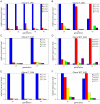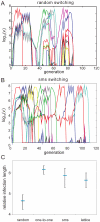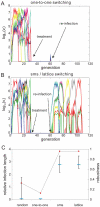Antigenic variation in Plasmodium falciparum malaria involves a highly structured switching pattern
- PMID: 21408201
- PMCID: PMC3048365
- DOI: 10.1371/journal.ppat.1001306
Antigenic variation in Plasmodium falciparum malaria involves a highly structured switching pattern
Abstract
Many pathogenic bacteria, fungi, and protozoa achieve chronic infection through an immune evasion strategy known as antigenic variation. In the human malaria parasite Plasmodium falciparum, this involves transcriptional switching among members of the var gene family, causing parasites with different antigenic and phenotypic characteristics to appear at different times within a population. Here we use a genome-wide approach to explore this process in vitro within a set of cloned parasite populations. Our analyses reveal a non-random, highly structured switch pathway where an initially dominant transcript switches via a set of switch-intermediates either to a new dominant transcript, or back to the original. We show that this specific pathway can arise through an evolutionary conflict in which the pathogen has to optimise between safeguarding its limited antigenic repertoire and remaining capable of establishing infections in non-naïve individuals. Our results thus demonstrate a crucial role for structured switching during the early phases of infections and provide a unifying theory of antigenic variation in P. falciparum malaria as a balanced process of parasite-intrinsic switching and immune-mediated selection.
Conflict of interest statement
The authors have declared that no competing interests exist.
Figures





References
-
- Berendt AR, Simmons DL, Tansey J, Newbold CI, Marsh K. Intercellular adhesion molecule-1 is an endothelial cell adhesion receptor for Plasmodium falciparum. Nature. 1989;341:57–59. - PubMed
-
- Roberts DD, Sherwood JA, Spitalnik SL, Panton LJ, Howard RJ, et al. Thrombospondin binds falciparum malaria parasitized erythrocytes and may mediate cytoadherence. Nature. 1985;318:64–66. - PubMed
-
- Turner GD, Morrison H, Jones M, Davis TM, Looareesuwan S, et al. An immunohistochemical study of the pathology of fatal malaria. Evidence for widespread endothelial activation and a potential role for intercellular adhesion molecule-1 in cerebral sequestration. Am J Pathol. 1994;145:1057–1069. - PMC - PubMed
Publication types
MeSH terms
Substances
Grants and funding
LinkOut - more resources
Full Text Sources

